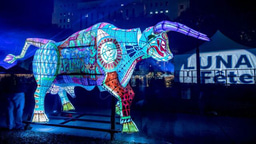The Past, Present, and Future of Virtual Production

Advances in the film industry are closely related to technological advances. So, it’s no wonder that technology has deeply impacted filmmaking, from pre-production to post-production.
In this article, we pay homage to the ever-evolving world of virtual production – looking at where it started, where it is today, and what its future might look like.
Virtual Production Past
Virtual production has been on everyone’s lips in the film industry for a couple of years, but like all technology, it didn’t simply poof into existence overnight. Let’s trace the incremental steps that brought us to the likes of The Mandalorian and more.
Virtual production is an umbrella term given to a whole suite of techniques, including motion capture, green screens, LED volumes, pre-visualization, and any content production with tracked 3D computer graphics, which have been driving progress in filmmaking since its inception.
Filming actors against a large LED screen displaying distant or non-existent locations has its roots in front- and rear-projection techniques. These projection techniques attempted to recreate atmospheres with a projection, where the location and actors were recorded at different times.
Chroma key technology, commonly known as blue and green screen technology, first gained popularity around the 1930s. Filmmakers initially used blue screens instead of green screens, as blue was more popular for TV production. Eventually, green screens would gradually replace most blue screens in Hollywood. In the early days of filmmaking, these screens were often used to produce mattes, which were utilized to combine two different scenes. For example, special effects artist Larry Butler, used the "blue screen traveling matte" technique in The Thief of Bagdad (1940). Over the years, green screens have expanded to include much more. But the problem with blue and green screens is that they reflect those colors onto the talent. In most cases, it requires careful lighting and post-production processing to eliminate the color spill.
Additionally, computer graphics-based virtual production is not new. The early use of CGI can be seen in movies such as Tron (1982) and The Abyss (1989), where computer-generated elements were combined with live-action footage. However, the concept began to take shape with the rise of digital filmmaking tools in the 2000s.
Virtual Production Present
Currently, the big trend in virtual production is using LED volumes. The technique combines real-time game engine animation using Unreal Engine, LED screens, and tracked cameras to deliver visual effects shots live and in-camera. Unreal Engine allowed a massive breakthrough: real-time rendered, photo-realistic CG backgrounds. If you’ve watched The Mandalorian, you’ve already witnessed the power of in-camera visual effects using LED volumes and virtual production in action. Many other shows and films have since followed suit.
With the evolution of technology, actors nowadays perform against an LED wall – replacing the famous green screen – that displays the virtual environment, which the production team generates and manipulates in real time. Instead of actors performing in real-world locations or green screens, they perform in front of a giant volume of LED panels with animated backgrounds that respond to the camera’s movement with accurate parallax.
Many recent major productions have been reconfigured to be partially or entirely shot on LED volumes, including Star Trek: Discovery, Thor: Love and Thunder, and Bullet Train.
The technique allows filmmakers to adjust lighting, camera angles, and other elements on the set as well as during production, giving them more control over the creative process. As virtual production progresses, it grants filmmakers more freedom to actualize their artistic visions.
Virtual Production Future
There are boundless ways that virtual production can evolve (and is already doing so). Advancements in technology are likely to make virtual production more integrated with other filmmaking techniques. Some trends shaping its future include real-time rendering, expansion into different genres, and more accessible tools. As a result, virtual production will permit filmmakers to produce more innovative and creative projects while offering greater flexibility and efficiency in the production process.
The future looks bright for indie filmmakers as well. Virtual production is not just limited to big-budget Hollywood productions. It has made it easier for indie filmmakers to work with smaller budgets while producing dazzling results, leading to many independent filmmakers exploring and embracing this technology. Take a look at Vashi Nedomansky’s virtual production case study, for inspiration, in which Nedomansky embarked on a virtual production journey for a professional hockey team, the Coachella Valley Firebirds.
As technology continues to evolve, the involvement of artificial intelligence in video production is also revolutionizing how videos are created and edited, pushing the boundaries of creativity and visual storytelling.
What do you think the future of virtual production looks like?






Please sign in or register for FREE
If you are a registered user on AVIXA Xchange, please sign in
Excellent article Iulia! I am fascinated by looking back as a way to inform the future of video content, and I am worried that throwing more pixels and tech at the problem often misses the point of what makes powerful and inspiring video content. "Hold on while I overthink this" has become one of my new mottos, especially when I am really inspired by someone just capturing something with a cell phone. I think art for me is by nature difficult, and when we come up with easy solutions like a digital backdrop instead of shooting on location and all the added complexities that creates, something is lost. But I acknowledge that I could be wrong and that something like the Mandalorian allows them to devote money and energy in other places.